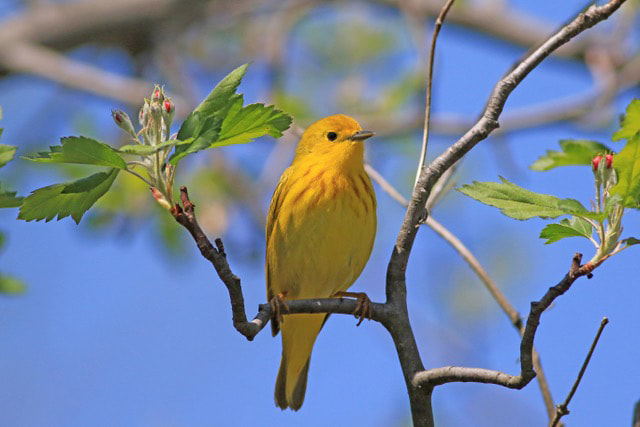|
The following was submitted by Dan Brauning of the Lycoming Audubon Society. They are coming. Heading here by the millions, mostly by night, these masses will arrive from the south, largely unseen. Most just pass overhead, but many will settle here, making their homes around us, unnoticed.
These nighttime invaders are clothed in remarkably bright colors of red, yellow, orange or subtle greens and black, and they are covered with feathers. It’s birds, of course, that are invading right now as they complete annual migrations, a puzzle to modern science and a marvel to those who tune into birds. We are all familiar with this cycle to one degree or another. The V-shaped flocks of geese moving north, honking noisily as they pass overhead, are hard to miss. Robins arriving in our neighborhoods are an anticipated sign of spring. Even vulture return is celebrated! But the well-named Yellow Warbler may go unnoticed, along with over 30 other warblers coming back from Central America in late April. They, along with over 100 species of songbirds undertake this incredible annual flight. The extent and scope of this spectacle in April and May is immense. An amazing variety of beautiful small songbirds, some weighing no more than a penny, make their homes in the hedgerows and woodlands of our region after wintering in Central and South America. Several types of flycatchers (which, yes, catch flying insects), as well as orioles, finches, thrushes and tanagers that look like they belong in the tropics are on their way. Each species finds a place with its own habitat and food preferences and contributes to the dizzying variety that makes up the bird world. Some do just pass through. Brilliant Cape May Warblers and Bay-breasted Warblers stop here briefly in May on their way to the extensive forests of northern Canada. Most songbirds are small and secretive, and complete their long flights at night in loose groups. They contact each other with gentle chip notes as they wing their way hundreds of miles on clear calm nights. Stopping each day to rest, they eagerly eat caterpillars and other “pests” to fuel the next leg of their journey. It is a marvel of life; an incredible journey completed twice each year — north and south. This time of year, we await the long-distant migrants, driven from these parts in fall by lack of insect food, but coming back like clockwork as spring temperatures soar. Barn Swallows complete an amazing movement from the Amazon basin in South America northward to build their nests on barns near us. As spring unfolds its regular cycle, be on the lookout for small birds darting through the tree-tops, or listen for new songs drifting from a hedge-row. These birds are not easy to spot — good binoculars or sharp ears are needed. But with study, following a modern field guide, you can learn to recognize those around you. Check out the Cornell Lab of Ornithology’s website that animates the migration movements of many species, based on the observations provided by thousands of birders at eBird.org (https://ebird.org/news/stem0717). These demonstrate the incredible pulse of life through the year. The birds that you’ve been watching at your feeder all winter are wonderful companions. But the migrants on their way from southern lands are thrilling and help us experience the awe of creation around us!
1 Comment
Leave a Reply. |
AuthorsRiverkeeper John Zaktansky is an award-winning journalist and avid promoter of the outdoors who loves camping, kayaking, fishing and hunting with the family. Archives
July 2024
Topics |

 RSS Feed
RSS Feed